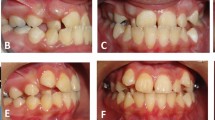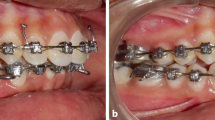Abstract
Objective
The objective of this study was to investigate the effects of fixed functional therapy on oropharyngeal airway dimensions and hyoid bone positions in Class II patients and make comparison with an untreated Class II group.
Materials and methods
Eighteen patients (8 girls, 10 boys; mean age 13.62 ± 1.92 years) who were treated with Forsus Fatique Resistant Device (FFRD) and 19 patients (11 girls, 8 boys; mean age 12.74 ± 0.91 years) who served as control were enrolled. Cephalograms were used to assess linear, angular, and area measurements. Intragroup comparisons were made by paired t and Wilcoxon tests and intergroup comparisons were performed by independent t test.
Results
With respect to controls, FFRD group showed increased airway dimensions at soft palate (P < 0.05) and more forward positioning of the hyoid bone (P < 0.05). Dentoalveolar changes exhibited mesial movement of lower incisors and molars and reduction in overjet (P < 0.001) in FFRD group.
Conclusions
Positive effects in oropharyngeal airway dimensions and increased values of hyoid bone displacement to a more forward position were found after fixed functional therapy.
Clinical Relevance
Treatment with fixed functional appliances is mostly based on mesial movement of mandibular dentition, which might influence changes in tongue posture. The present results might indicate that oropharyngeal airway dimensions may be affected by postural changes of the hyoid bone in consequence of dentoalveolar changes. Clinically, these may be considered especially in Class II cases with reduced airway dimensions.




Similar content being viewed by others
References
McNamara Jr JA (1981) Components of class II malocclusion in children 8–10 years of age. Angle Orthod 51:177–202
Claudino LV, Mattos CT, Ruellas AC, Sant’ Anna EF (2013) Pharyngeal airway characterization in adolescents related to facial skeletal pattern: a preliminary study. Am J Orthod Dentofac Orthop 143:799–809
El H, Palomo JM (2013) An airway study of different maxillary and mandibular sagittal positions. Eur J Orthod 35:262–270
Gunay EA, Arun T, Nalbantgil D (2011) Evaluation of the immediate dentofacial changes in late adolescent patients treated with the Forsus(™) FRD. Eur J Dent 5:423–432
Franchi L, Alvetro L, Giuntini V, Masucci C, Defraia E, Baccetti T (2011) Effectiveness of comprehensive fixed appliance treatment used with the Forsus Fatigue Resistant Device in class II patients. Angle Orthod 81:678–683
Restrepo C, Santamaria A, Pelaez S, Tapias A (2011) Oropharyngeal airway dimensions after treatment with functional appliances in class II retrognathic children. J Oral Rehabil 38:588–594
Zhou L, Zhao Z, Lu D (2000) The analysis of the changes of tongue shape and position, hyoid position in class II, division 1 malocclusion treated with functional appliances (FR-I). Hua Xi Kou Qiang Yi Xue Za Zhi 18:123–125
Hanggi MP, Teuscher UM, Roos M, Peltomaki TA (2008) Long-term changes in pharyngeal airway dimensions following activator-headgear and fixed appliance treatment. Eur J Orthod 30:598–605
Ozbek MM, Memikoglu TU, Gögen H, Lowe AA, Baspinar E (1998) Oropharyngeal airway dimensions and functional-orthopedic treatment in skeletal class II cases. Angle Orthod 68:327–336
O’Brien K, Wright J, Conboy F, Sanjie Y, Mandall N, Chadwick S, et al. (2003) Effectiveness of treatment for class II malocclusion with the Herbst or twin-block appliances: a randomized, controlled trial. Am J Orthod Dentofac Orthop 124:128–137
Karacay S, Akin E, Olmez H, Gurton AU, Sagdic D (2006) Forsus nitinol flat spring and jasper jumper corrections of class II division 1 malocclusions. Angle Orthod 76:666–672
Aras A, Ada E, Saracoğlu H, Gezer NS, Aras I (2011) Comparison of treatments with the Forsus fatigue resistant device in relation to skeletal maturity: a cephalometric and magnetic resonance imaging study. Am J Orthod Dentofac Orthop 140:616–625
Jones G, Buschang PH, Kim KB, Oliver DR (2008) Class II non-extraction patients treated with the Forsus Fatigue Resistant Device versus intermaxillary elastics. Angle Orthod 78:332–328
Aslan BI, Kucukkaraca E, Turkoz C, Dincer M (2014) Treatment effects of the Forsus Fatigue Resistant Device used with miniscrew anchorage. Angle Orthod 84:76–87
Cacciatore G, Ghislanzoni LT, Alvetro L, Giuntini V, Franchi L (2014) Treatment and posttreatment effects induced by the Forsus appliance: a controlled clinical study. Angle Orthod 84:1010–1017
Servello DF, Fallis DW, Alvetro L (2015) Analysis of class II patients, successfully treated with the straight-wire and forsus appliances, based on cervical vertebral maturation status. Angle Orthod 85:80–86
Bilgiç F, Başaran G, Hamamci O (2015) Comparison of Forsus FRD EZ and Andresen activator in the treatment of class II, division 1 malocclusions. Clin Oral Investig 19:445–451
Germec-Cakan D, Taner T, Akan S (2011) Uvulo-glossopharyngeal dimensions in non-extraction, extraction with minimum anchorage, and extraction with maximum anchorage. Eur J Orthod 33:515–520
Jena AK, Singh SP, Utreja AK (2013) Effectiveness of twin-block and mandibular protraction appliance-IV in the improvement of pharyngeal airway passage dimensions in class II malocclusion subjects with a retrognathic mandible. Angle Orthod 83:728–734
Kinzinger G, Czapka K, Ludwig B, Glasl B, Gross U, Lisson J (2011) Effects of fixed appliances in correcting angle class II on the depth of the posterior airway space: FMA vs. Herbst appliance—a retrospective cephalometric study. J Orofac Orthop 72:301–320
Ozdemir F, Ulkur F, Nalbantgil D (2014) Effects of fixed functional therapy on tongue and hyoid positions and posterior airway. Angle Orthod 84:260–264
Li Y (2009) Early orthodontic treatment of skeletal class II malocclusion may be effective to prevent the potential for OSAHS and snoring. Med Hypotheses 73:594–595
Vizzotto MB, Liedke GS, Delamare EL, Silveira HD, Dutra V, Silveira HE (2012) A comparative study of lateral cephalograms and cone-beam computed tomographic images in upper airway assessment. Eur J Orthod 34:390–393
Pirila-Parkkinen K, Löppönen H, Nieminen P, Tolonen U, Paakkö E, Pirttiniemi P (2011) Validity of upper airway assessment in children: a clinical, cephalometric, and MRI study. Angle Orthod 81:433–439
Oh KM, Hong JS, Kim YJ, Cevidanes LS, Park YH (2011) Three-dimensional analysis of pharyngeal airway form in children with anteroposterior facial patterns. Angle Orthod 81:1075–1082
Aboudara C, Nielsen I, Huang JC, Maki K, Miller AJ, Hatcher D (2009) Comparison of airway space with conventional lateral headfilms and 3-dimensional reconstruction from cone-beam computed tomography. Am J Orthod Dentofac Orthop 135:468–479
Stahl F, Baccetti T, Franchi L, McNamara Jr JA (2008) Longitudinal growth changes in untreated subjects with class II division 1 malocclusion. Am J Orthod Dentofac Orthop 134:125–137
Chen Y, Hong L, Wang CL, Zhang SJ, Cao C, Wei F, et al. (2012) Effect of large incisor retraction on upper airway morphology in adult bimaxillary protrusion patients. Angle Orthod 82:964–970
Muto T, Yamasaki A, Takeda S (2008) A cephalometric evaluation of the pharyngeal airway space in patients with mandibular retrognathia and prognathia, and normal subjects. Int J Oral Maxillofac Surg 37:228–231
Wang Q, Jia P, Anderson NK, Wang L, Lin J (2012) Changes of pharyngeal airway size and hyoid bone position following orthodontic treatment of class I bimaxillary protrusion. Angle Orthod 82:115–121
Author information
Authors and Affiliations
Corresponding author
Ethics declarations
Conflict of interest
The authors declared that they have no conflict of interest.
Rights and permissions
About this article
Cite this article
Bavbek, N.C., Tuncer, B.B., Turkoz, C. et al. Changes in airway dimensions and hyoid bone position following class II correction with forsus fatigue resistant device. Clin Oral Invest 20, 1747–1755 (2016). https://doi.org/10.1007/s00784-015-1659-1
Received:
Accepted:
Published:
Issue Date:
DOI: https://doi.org/10.1007/s00784-015-1659-1




